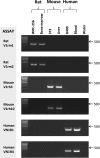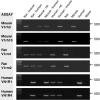Species identification and authentification of human and rodent cell cultures using polymerase chain reaction analysis of vomeronasal receptor genes
- PMID: 21938467
- PMCID: PMC3217067
- DOI: 10.1007/s10616-011-9394-1
Species identification and authentification of human and rodent cell cultures using polymerase chain reaction analysis of vomeronasal receptor genes
Abstract
Cell culture and the use of cell lines are routinely used in basic scientific research. It is therefore imperative for researchers to ensure the origin of the cell lines used and that they are routinely re-analysed for contamination and misidentification. Inter-species contamination is relatively frequent, and the most commonly used cell lines are of human, mouse and rat derivation. We have developed simple species specific primer assays based on genomic sequence differences in vomeronasal receptor gene family members to discriminate between human, mouse and rat DNA using standard agarose gel electrophoresis. Furthermore, these PCR assays are able to identify the species composition within an inter-species mixed population. This approach therefore provides a valuable tool to enable a rapid, simple and relatively inexpensive determination of the authentication and contamination of cell cultures.
Figures


Similar articles
-
Human, mouse or rat? Species authentication of glioma-derived cell cultures.J Neurosci Methods. 2010 Dec 15;194(1):139-43. doi: 10.1016/j.jneumeth.2010.10.002. Epub 2010 Oct 14. J Neurosci Methods. 2010. PMID: 20951163
-
Rapid identification and authentication of closely related animal cell culture by polymerase chain reaction.In Vitro Cell Dev Biol Anim. 2008 Jul-Aug;44(7):224-7. doi: 10.1007/s11626-008-9121-1. Epub 2008 Jun 14. In Vitro Cell Dev Biol Anim. 2008. PMID: 18553210
-
Identification and authentication of animal cell culture by polymerase chain reaction amplification and DNA sequencing.In Vitro Cell Dev Biol Anim. 2003 Nov-Dec;39(10):424-7. doi: 10.1290/1543-706X(2003)039<0424:IAAOAC>2.0.CO;2. In Vitro Cell Dev Biol Anim. 2003. PMID: 14753847
-
Detection of mycoplasma contaminations in cell cultures by PCR analysis.Hum Cell. 1999 Dec;12(4):229-36. Hum Cell. 1999. PMID: 10834110 Review.
-
Characterization and authentication of cancer cell lines: an overview.Methods Mol Biol. 2011;731:35-43. doi: 10.1007/978-1-61779-080-5_4. Methods Mol Biol. 2011. PMID: 21516396 Review.
Cited by
-
Investigation of the utility of the 1.1B4 cell as a model human beta cell line for study of persistent enteroviral infection.Sci Rep. 2021 Aug 2;11(1):15624. doi: 10.1038/s41598-021-94878-y. Sci Rep. 2021. PMID: 34341375 Free PMC article.
-
Low-Level Mouse DNA in Conditioned Medium Generates False Positive Cross-Species Contamination Results in Human Organoid Cultures.Front Cell Dev Biol. 2020 Nov 6;8:587107. doi: 10.3389/fcell.2020.587107. eCollection 2020. Front Cell Dev Biol. 2020. PMID: 33240885 Free PMC article.
-
Mouse cell line authentication.Cytotechnology. 2014 Jan;66(1):133-47. doi: 10.1007/s10616-013-9545-7. Epub 2013 Feb 22. Cytotechnology. 2014. PMID: 23430347 Free PMC article.
References
-
- Capes-Davis A, Freshney RI (2009) Database of cross-contaminated or misidentified cell lines. European collection of cell cultures. http://www.hpacultures.org.uk/media/E50/3B/CellLineCrossContaminationsv6... - PubMed
LinkOut - more resources
Full Text Sources

